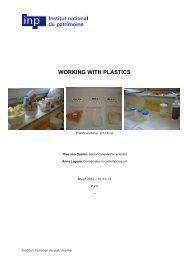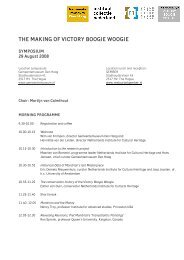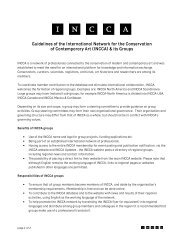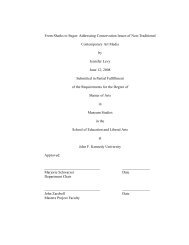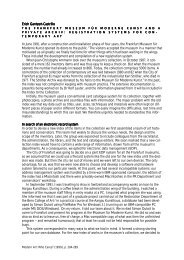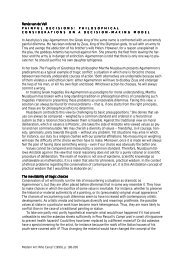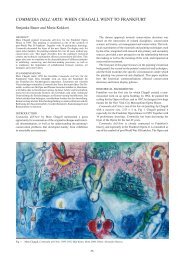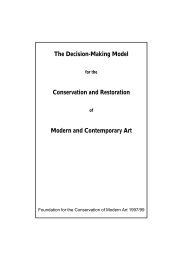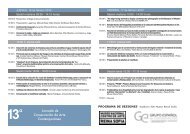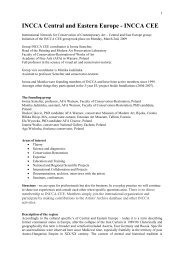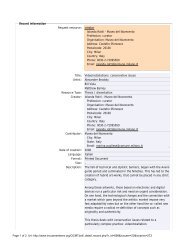Conservation Issues of Modern and Contemporary Art ... - The Getty
Conservation Issues of Modern and Contemporary Art ... - The Getty
Conservation Issues of Modern and Contemporary Art ... - The Getty
Create successful ePaper yourself
Turn your PDF publications into a flip-book with our unique Google optimized e-Paper software.
• Create more documentation specialists (e.g., Tate’s Information Coordinator).<br />
• Establish a st<strong>and</strong>ard terminology.<br />
Installation <strong>Art</strong><br />
• Create, share, <strong>and</strong> test models <strong>and</strong> new technologies for documentation <strong>of</strong><br />
installation art that include new parameters: light, sound, motion, 3D, etc.,<br />
building on those explored in the Inside Installations project<br />
(http://www.inside-installations.org).<br />
• Test documentation models <strong>and</strong> technologies via installations at other<br />
institutions.<br />
• Encourage more collectors/institutions to test models <strong>and</strong> provide accessible<br />
case studies.<br />
• Create best practice guides.<br />
• Work toward a methodological approach.<br />
Time-Based Media<br />
• Evaluate <strong>and</strong> utilize existing methods for documenting moving images (such as<br />
those used in libraries, industry, etc.) for time-based media.<br />
Dissemination<br />
Dissemination <strong>and</strong> information sharing are considered absolutely key to improving the<br />
field, in both the short-term <strong>and</strong> the long-term. A number <strong>of</strong> ideas were discussed on<br />
how to facilitate the exchange <strong>of</strong> information <strong>and</strong> experiences.<br />
Publications<br />
Dissemination <strong>and</strong> information sharing ideas related to publications included:<br />
• launching an online peer reviewed journal that would link conservation, art<br />
history thinking <strong>and</strong> research, <strong>and</strong> beyond (e.g., visual culture, sociology, etc.),<br />
in recognition <strong>of</strong> the fact that all these perspectives inform the way we look at<br />
<strong>and</strong> live with art made in our time;<br />
• making far better use <strong>of</strong> existing journals—for example, Reviews in <strong>Conservation</strong><br />
for overviews <strong>of</strong> the pr<strong>of</strong>ession to date, <strong>and</strong> <strong>Art</strong> Forum <strong>and</strong> Future Anterior—to<br />
target the interdisciplinary audience <strong>of</strong> conservators <strong>and</strong> art historians;<br />
• facilitating access to master’s theses <strong>and</strong> student research projects through links<br />
to ENCoRE, VDR, <strong>and</strong> ANAGPIC.<br />
Conferences<br />
Conferences are still viewed as essential to the field in terms <strong>of</strong> keeping abreast <strong>of</strong><br />
current research, as well as fostering larger debates through panel discussions <strong>and</strong><br />
audience participation. It was thought that, ideally, a series <strong>of</strong> conferences could be<br />
developed that would:<br />
• be attended by a maximum <strong>of</strong> 200 people (to facilitate discussion);<br />
• be focused on a specific themes that should involve invited <strong>and</strong> targeted<br />
specialists, thereby engaging other disciplines, especially those in science;<br />
• be accompanied by a Web-based publication;<br />
• include, potentially, the following themes: coatings; failure (<strong>of</strong> materials); timebased<br />
media; ephemeral (transitory) objects; <strong>and</strong> preventive conservation.<br />
8



